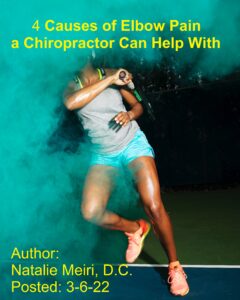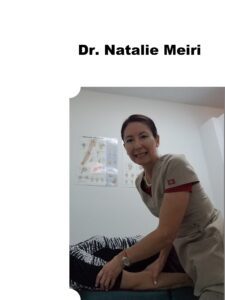
This post is about 4 Causes of Elbow Pain a Chiropractor Can Help With. As the link between the shoulder and the wrist/hand, your elbows are challenged with repetitive activities. These overuse mechanisms account for the majority of elbow pain. In particular for instance in throwing sports and in activities requiring the use of an arm extension device such as a bat, racquet, or club. So the pivot is at the elbow and your forearm acts as the lever arm. These devices increase the medial (toward the center) stress across the elbow by increasing the length of the lever arm.
Additionally, you may also have a fall. And as with the rest of the upper extremity (arm), the elbow becomes weight bearing during the fall. An axial (racquet) force (load is applied to the structure along the length) is applied acutely during this fall to your elbow. Furthermore, this can happen chronically with gymnastic maneuvers and even with some chiropractors due to adjusting maneuvers!
1. Lateral Epicondylitis (Tennis Elbow)
Lateral epicondylitis causes lateral (outer or same side as thumb) elbow pain associated with a repetitive sport or occupational activity. Repetitive movements requiring forceful wrist extension (movement of raising the back of the hand), radial deviation (bending the wrist to the thumb), and supination (rotation of the forearm) are the most common causes. Although it is associated with tennis, other sports and occupational activities are also possible causes. Butchers, plumbers, and weavers are examples of those who may be affected. With tennis, novice players with poor backhand technique account for many cases. With professional players, the forehand or serving may be the cause. Obviously, the more frequently an individual plays, the higher the risk of developing tennis elbow. Although, lateral epicondylitis is called tennis elbow, it also occurs in computer keyboardists, carpenters, and golfers.
Cause:
The currently accepted theory is that initially there is tearing of the extensor carpi radialis brevis (ECRB) muscle origin (attachment). This process may extend to the extensor digitorum communis (EDC) or the extensor carpi radialis longus (ECRL) muscles. These muscles in conjunction with the other muscles and tendons in your forearm help move your wrist and hand. The histologic (seen by microscope) description of the change in tissue is called angiofibroblastic hyperplasia. Angiofibroblastic hyperplasia or angiofibroblastic tendinosis describes the pathologic (disease cause) alterations seen in the tissue of tendonitis (inflammation of tendon).
Radiographs (xrays) may demonstrate calcification in as many as 25% of patients with lateral epicondylitis.
2. Medial Epicondylitis (Golfer’s Elbow)
Medial Epicondylitis causes medial (inner) elbow pain following a repetitive activity such as golfing, hammering or use of a screwdriver. In athletes, the inciting activity usually involves wrist flexion (moving wrist down so palm faces arm) and pronation (rotatory movement of elbow where palm faces down). Examples of these include in serving and overhead and forehand strokes in various sports. Obviously, golfing (“golfer’s elbow”) or throwing may also cause symptoms. You may also feel pain or weakness on gripping.
Cause:
Medial epicondylitis is a tendinopathy of the origin of the wrist flexors and pronator teres muscles in your forearm. In chronic cases, an elbow flexion contracture may occur, leading to restrictions of movement (eg. extension). An ulnar neuropathy (compression of ulnar nerve at elbow) may coexist with medial epicondylitis. Radiographs (xrays) may reveal calcifications in close proximity to the medial epicondyle in 20% to 30% of patients with epicondylitis.
3. Triceps Tendinitis (Posterior Tennis Elbow)
The triceps is a large muscle on the back of your upper limb. Triceps tendinitis causes pain at the tip of the elbow after a repetitive extension activity or a single event involving forceful elbow extension.
Cause:
Strain of the triceps insertion on the olecranon (bony prominence of the elbow) is usually due to common athletic endeavors performed by boxers, weight lifters, pitchers, and occasionally tennis players.
4. Posterior Impingement Syndrome
Posterior Impingement Syndrome usually occurs in an athlete and especially on quick extension of the elbow. You will have a sharp posterior (back of) elbow pain. Similarly, popping or clicking may occur with extension. Your elbow may occasionally lock.
Cause:
Firstly, repetitive extension leads to compression between the olecranon trochlea and olecranon fossa (1 of 3 joints of elbow). Secondly, this may simply cause a reactive synovitis. So the synovium is connective tissue that lines the inside of the joint capsule. Thirdly, synovitis (synovial inflammation) is when the synovium of a joint becomes inflamed (swollen). Lastly, it may progress to degeneration and the production of osteophytes (bone spurs) or loose bodies.

Elbow Pain Treatment at Meiri Chiropractic in North Palm Beach
In the acute phase, ice and rest from the causative activity are essential. Myofascial release techniques are effective. Furthermore, Chiropractic adjustments, manipulation, and mobilization to the elbow and associated areas give relief.
A recently published study compared manipulation of the wrist with a second protocol of ultrasound, friction massage, and muscle stretching and strengthening for the management of lateral epicondylitis. Success was better for chiropractic manipulation of the wrist compared to the traditional physical therapy of ultrasound, massage, and muscle stretching/strengthening approach.
Getting regular chiropractic care from a West Palm Beach elbow pain chiropractor can help relieve pain naturally from an already existing injury, or even offer injury prevention. Chiropractic is a holistic and natural way to not only treat existing injuries, but to keep your body in its best working condition.
Contact Meiri Chiropractic today on the 4 causes of elbow pain a chiropractor can help with or/and other ailments.
References:
Thomas Bergman, David Peterson, Chiropractic Technique Principles and Procedures, 3rd edition, 2011
Video on same post
Meiri Chiropractic
561-253-8984